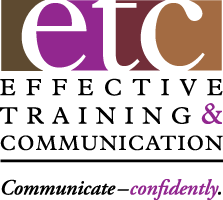Reaction to the last two pieces has been great. Looks like you enjoyed poking fun at both bosses and colleagues who were poor communicators. We concluded that many of them were hired or promoted in spite of their communication skills, rather than because of them.
And the reasons were ironically similar:
- Not on the ‘test’. Few organizations place written or verbal skills on the ‘gotta have’ list when interviewing candidates for any level position, unless they’re in sales or customer-facing areas.
- No big deal. Many employers don’t include written or verbal skills in their performance management system because they don’t see that much value in them.
- They didn’t learn them in school. Most high schools offer few, if any, courses in presentation or interpersonal communication skills. The same is true for many college business curricula. So, organizations must often provide their staffs verbal and written communication training to make up for that, but, most of them don’t.
So much for the causes of the problem, but what about the solutions? What can organizations do to make sure no one asks why their company ‘stinks at communicating.’? Read on for 10 effective Best Practices to create organizations that value excellence in communication … and don’t stink!
- It starts at the top. C-level leaders must commit to creating and sustaining an enterprise-wide culture that values and rewards effective communication.
- If that’s too big a challenge, given the organization’s size and scope, then ‘enlightened’ executives can focus this effort in their respective division or department. So, if the whole organization can’t embrace the goal, maybe the Finance or Manufacturing departments could.
- A key component of the process is to make sure communication competencies are ‘on the test’. That means adding these factors to the ‘gotta have’ list for any open position, no matter the role or level. While they can’t be the most important criteria, they could be the tie-breaker between two otherwise similarly qualified candidates.
- Once baked into the selection process, the next step is to include them in the performance management system. If employees at all levels see that demonstrating specific workplace communication skills as a piece of their objectives, they’ll pay attention.
- If their performance evaluations include quantifiable skill improvements, they’ll pay more attention.
- And if those evaluations directly impact their salary increases and readiness for advancement, they’ll really pay a lot of attention.
- Then, regularly communicate about communication. Build communication strengths and weaknesses into the ongoing performance coaching process. With each conversation, include what’s working and what still needs more work.
- Besides these formal conversations, regularly include informal feedback on specific memos, presentations and interactions.
- Offer professional development programs in writing, phone skills, meeting management and presentation skills. Commit to empower all employees to improve all their workplace skills, including communication.
- Master the skills. Work hard to be a positive model of these competencies to influence staff. Regularly ask for feedback from them on your effort and results. Walk the walk.
While improving an entire organization’s communicating competencies can be a daunting long term challenge, simply start small with your immediate reports and watch it catch on and grow from there. Do what you can to make sure no one asks ‘Why does my company stink at communicating?’
(Note – a version of this content first appeared in the Council of Smaller Enterprises ‘Mind Your Business’ e-letter in September,)
